Related Research Articles

The Countryside Council for Wales was a Welsh Assembly sponsored body responsible for wildlife conservation, landscape and countryside access authority of Wales.
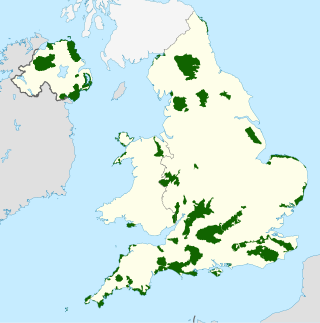
An Area of Outstanding Natural Beauty is an area of countryside in England, Wales, and Northern Ireland, that has been designated for conservation due to its significant landscape value. Areas are designated in recognition of their national importance by the relevant public body: Natural England, Natural Resources Wales, and the Northern Ireland Environment Agency respectively. In place of AONB, Scotland uses the similar national scenic area (NSA) designation. Areas of Outstanding Natural Beauty enjoy levels of protection from development similar to those of UK national parks, but unlike national parks the responsible bodies do not have their own planning powers. They also differ from national parks in their more limited opportunities for extensive outdoor recreation.
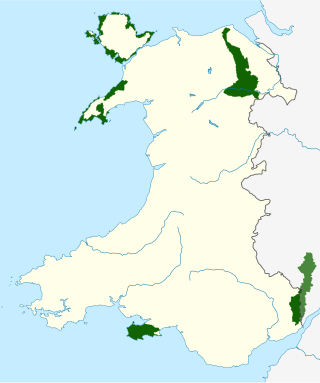
There are five Areas of Outstanding Natural Beauty (AONBs) in Wales. AONBs are areas of countryside that have been designated for statutory protection, due to their significant landscape value, by initially the Government of the United Kingdom and later Welsh devolved bodies. Of the current five areas designated, four are wholly in Wales, with another spanning the Wales-England border, and in total AONBs account for 4% of Wales' land area.

Adam Robert Price is a Welsh politician who served as Leader of Plaid Cymru from 2018 to 2023. He has been the Member of the Senedd (MS) for Carmarthen East and Dinefwr since 2016, having previously been a Member of Parliament (MP) for the same Westminster constituency from 2001 to 2010.

Ammanford is a town and community in Carmarthenshire, Wales, with a population of 5,411 at the 2011 census. It is a former coal mining town. The built-up area had a population of 7,945 with the wider urban area even bigger.

Maesteg is a town and community in Bridgend County Borough, Wales. Maesteg lies at the northernmost end of the Llynfi Valley, close to the border with Neath Port Talbot. In 2011, Maesteg had a population of 20,612. The English translation of Maesteg is 'fair field'.
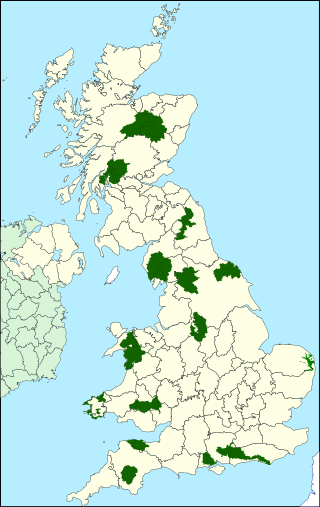
National parks of the United Kingdom are areas of relatively undeveloped and scenic landscape across the country. Despite their name, they are quite different from national parks in many other countries, which are usually owned and managed by governments as protected community resources, and which do not usually include permanent human communities. In the United Kingdom, an area designated as a national park may include substantial settlements and human land uses that are often integral parts of the landscape. Land within national parks remains largely in private ownership. These parks are therefore not "national parks" according to the internationally accepted standard of the IUCN but they are areas of outstanding landscape where planning controls are a little more restrictive than elsewhere.
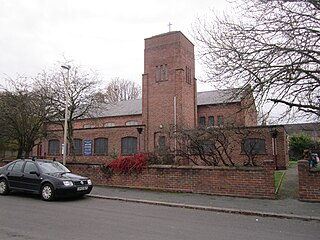
Blacon is a council estate on the outskirts of Chester, England. It was once one of the largest council housing estates in Europe.

Carmarthen East and Dinefwr is a constituency of the House of Commons of the Parliament of the United Kingdom represented since 2010 by Jonathan Edwards of Plaid Cymru. It elects one Member of Parliament (MP) by the first past the post system of election. It was created in 1997, mostly from the former seat of Carmarthen.
The City and County of Swansea is an urban centre with a largely rural hinterland in Gower; the city has been described as the regional centre for South West Wales. Swansea's travel to work area, not coterminous with the local authority, also contained the Swansea Valley in 1991; the new 2001-based version merges the Swansea, Neath & Port Talbot, and Llanelli areas into a new Swansea Bay travel to work area. Formerly an industrial centre, most employment in the city is now in the service sector.
Gomer Press is a family printing company based in Llandysul, west Wales. It was the largest publishing house in Wales.
Honno is a Welsh women's press, based in Aberystwyth, which is run as an independent co-operative. The press concentrates solely on publishing writing by the women of Wales, with the twin aims of increasing publication opportunities for Welsh women and expanding the audience for Welsh women's writing. In 2006, Dai Smith, chair of the Arts Council of Wales, praised Honno's "terrific work in bringing women’s literature back into print". Luned Meredith, one of the founders, claimed in the press's 21st anniversary year of 2008 that Honno had made "a significant contribution to the changing social conscience which has given prominence to the woman's voice".
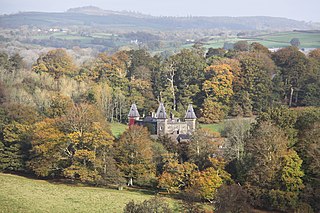
Dinefwr Park National Nature Reserve is an 800 acres (320 ha) estate about a mile from the centre of Llandeilo in Carmarthenshire owned by the National Trust, with a mansion in the centre. The highest point is occupied by the ruined Dinefwr Castle, ancient castle of the Deheubarth kingdom. It is a grade I Historic Park and a Site of Special Scientific Interest.

Wales, a country that is part of the United Kingdom, contains protected areas under various designations. The largest designation by land area is Wales' three national parks, followed by the five Areas of Outstanding Natural Beauty.
Russell Deacon works in governance and policy.

The Campaign for the Protection of Rural Wales (CPRW) (Welsh: Ymgyrch Diogelu Cymru Wledig (YDCW)), originally named the Council for the Preservation of Rural Wales, is a charity in Wales that aims to secure the protection and enhancement of the country's landscapes and environment.

The biodiversity of Wales is the wide variety of ecosystems, living organisms, and the genetic makeups found in Wales.
Low-impact development (LID) has been defined as "development which through its low negative environmental impact either enhances or does not significantly diminish environmental quality".

Tir Gofal was an agri-environmental scheme in Wales launched by the Countryside Council for Wales in 1999. It aimed to encourage farmers and landowners to manage their land in an environmentally friendly way. Its main objectives were "to protect and enhance habitats of importance to wildlife, to protect the historic environment, to protect and restore rural landscapes and to promote public access to the countryside." The scheme operated under the Common Agricultural Policy, and was jointly funded by the European Union and the United Kingdom Government. In 2011, the scheme was transferred into the management of the Welsh Government and subsequently replaced by another environmental scheme, Glastir.
References
- 1 2 "Sustainable Land Use in European Protected Areas" IUCN Regional Office for Europe, pp. 5-6 Archived 2006-11-08 at the Wayback Machine ;
- 1 2 "Tir Cymen". Countryside Council for Wales. Archived from the original on 11 March 2007. Retrieved 21 December 2016.
- ↑ "Area Summaries: Dyfed" Royal Commission on the Ancient and Historical Monuments of Wales Archived 2007-03-13 at the Wayback Machine